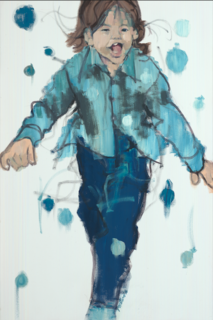
Garrett
Garrett lives his best life every single day. He is lights up the room and puts a smile on the face of those around him. Despite the challenges he faces, he is extremely happy and showers those around him with love.
He loves school and all the people he interacts with—teachers, staff, and students. They refer to him as the mayor based on his outgoing personality and interest in meeting and talking with everyone.
He loves sports. While he is somewhat limited in what he can physically do because of his disease, he still loves playing on his Challenger baseball team. He is a huge fan of the Bills, the Mets and all of his older brothers’ and older sister’s teams.
~Justin, Garrett’s Dad
Acid Sphingomyelinase Deficiency
The phenotype of acid sphingomyelinase deficiency (ASMD) occurs along a continuum. Individuals with the severe early-onset form, infantile neurovisceral ASMD, were historically diagnosed with Niemann-Pick disease type A (NPD-A). The later-onset, chronic visceral form of ASMD is also referred to as Niemann-Pick disease type B (NPD-B). A phenotype with intermediate severity is also known as chronic neurovisceral ASMD (NPD-A/B). The most common presenting symptom in NPD-A is hepatosplenomegaly, usually detectable by age three months; over time the liver and spleen become massive in size. Psychomotor development progresses no further than the 12-month level, after which neurologic deterioration is relentless. Failure to thrive typically becomes evident by the second year of life. A classic cherry-red spot of the macula of the retina, which may not be present in the first few months, is eventually present in all affected children. Interstitial lung disease caused by storage of sphingomyelin in pulmonary macrophages results in frequent respiratory infections and often respiratory failure. Most children succumb before the third year of life. NPD-B generally presents later than NPD-A, and the manifestations are less severe. NPD-B is characterized by progressive hepatosplenomegaly, gradual deterioration in liver and pulmonary function, osteopenia, and atherogenic lipid profile. No central nervous system (CNS) manifestations occur. Individuals with NPD-A/B have symptoms that are intermediate between NPD-A and NPD-B. The presentation in individuals with NPD-A/B varies greatly, although all are characterized by the presence of some CNS manifestations. Survival to adulthood can occur in individuals with NPD-B and NPD-A/B.
Artist: Kimberly Cusack




